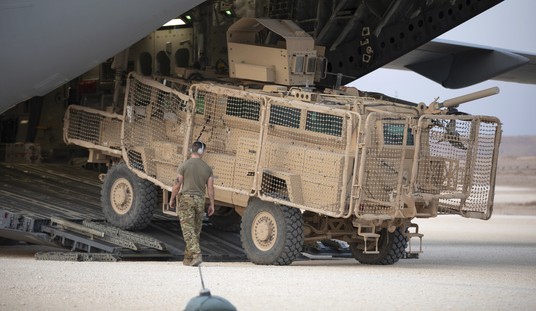If you follow the news through American media, you might be forgiven for not knowing what’s going on in the Middle East. They’ve been rather preoccupied lately with the trials and tribulations of Stormy Daniels, as well as Robert Mueller’s pursuit of the will-o’-the-wisp of Trump’s alleged “collusion” with the Russians; more conservative outlets continue to obsess over whether or not Hillary Clinton ought to be investigated and indicted.
Meanwhile, it’s been a busy month and a half outside our borders.
The latest exchange in the Middle East began when Israel intercepted an armed Iranian drone that entered Israeli airspace after violating Jordanian air space. The drone was shot down by an Israeli helicopter, and Israel responded by knocking out the Iranian command and control center in Syria. The Syrians made a lucky shot and downed one Israeli F-16; though both of the pilots were injured, they were able to get the stricken plane back over Israeli territory before it crashed, and thus bailed out and were rescued there.
Then the latest Syrian atrocity came in the form of a chlorine gas attack on a stubborn rebel enclave near Damascus. The thing about chlorine gas that renders it particularly horrible is that it’s heavier than air, and the long-suffering Syrian civilian population of the enclave, accustomed to nightly shelling from Syrian artillery, sought shelter in cellars underground, where the gas seeped in and killed quite a few people. The immediate response was a joint American, British, and French effort to disable the base from where the helicopter that dropped that gas canister came.
Israel used the chaos and confusion resulting from that allied attack to mount one of her own against a joint Syrian-Iranian base near the city of Hama, the headquarters of all the Iranian Revolutionary Guards Corps activities in Syria. The raid resulted in a spectacular explosion when the Israeli fighters wiped out a major Iranian ammunition storage facility.
This was followed by belligerent statements from all four of the major parties to the conflict in Syria; in particular, the Russians claimed they were prepared to supply the S-300 anti-aircraft system to the Syrians, known to NATO as the SA-10. In response, Israel carefully allowed it to be leaked that Israeli tank transporters were moving in column northward, toward the Syrian frontier.
Then, last Wednesday, the Iranian military response to the raid on Hama came in the form of 20 missiles launched by a Quds Force unit at Israeli positions on the Golan Heights. For days, Israeli authorities had been warning residents of the northern Galil and the Golan that something was brewing. In the event, sixteen of the Iranian missiles fell short and landed in Syrian territory. The four missiles which succeeded in crossing into Israeli airspace were intercepted by the Iron Dome missile defense system, resulting in minimal damage on the Israeli side and no casualties.
The Israelis immediately retaliated with a massive air raid, larger than anything since the 1973 Yom Kippur War, targeting dozens of Iranian sites in Syria including observation posts, headquarters, and ammunition dumps. When Syrian air defenses attempted to intervene, the Israelis targeted several Syrian SA-2, SA-5, SA-7, and SA-22 radar and missile installations. When the smoke cleared, the Syrian Observatory, as reported by the AP, counted 23 dead, including 18 “foreigners,” presumably all Iranians. The Russians carefully stayed out of the fight; all Israeli aircraft, the IAF reported, returned home safely.
A matter of hours after the devastating Israeli raid, Israeli Prime Minister Benjamin Netanyahu met with Russian Federation President Vladimir Putin to have a frank discussion about Israeli security concerns. One apparent result, as reported by Reuters on Friday, was that the Russian government was not engaged in talks with the Assad regime concerning deliveries of the S-300 air defense system. Apparently the miserable performance of Russian air defense equipment already in Syrian hands, as well as the failure of Iranian defenses to shoot down even one Israeli aircraft, convinced them that it would be bad for sales to other countries. Russia wouldn’t want to provide their most advanced system to the Syrians and have it fail utterly against the IAF, too.
None of this has done any harm to Netanyahu’s domestic standing. To understand the Israeli polling results, you have to know that in Israel one doesn’t vote for an individual but for a party; the head of the largest party faction in the 120-seat Knesset usually forms a coalition of 61 or more seats in order to govern (no single party has ever won an outright majority in Israeli history).
With this in mind, the latest Israeli poll shows Netanyahu’s Likud party shooting up in popularity, with 35 seats (at the beginning of April they had 28).
Next is Ya’ir Lapid’s Yesh Atid with 18 seats; the Zionist Union (left of center) with 14 seats; the Joint List (primarily Arab) with 12 seats; HaBayith haYehudi (nationalist) with 8 seats; Yahaduth haTorah (Ashkenazi religious) with 7 seats; Yisrael Beytenu (secular nationalist) and Kulanu (centrist) with 6 seats each; Orly Levi-Abekassis (a new splinter party from Yisrael Beytenu) with 5 seats; Meretz (far left) with 5 seats; and Shas (Sefardic religious) with 4 seats.
If the current coalition were reformed after a new election, it would have Likud (35 seats); HaNayith haYehudi (8 seats); Yahaduth haTorah (7 seats); Yisrael Beytenu (6 seats); Kulanu (6 seats) and Shas (4 seats), which would yield a very comfortable 66-seat majority.









Join the conversation as a VIP Member